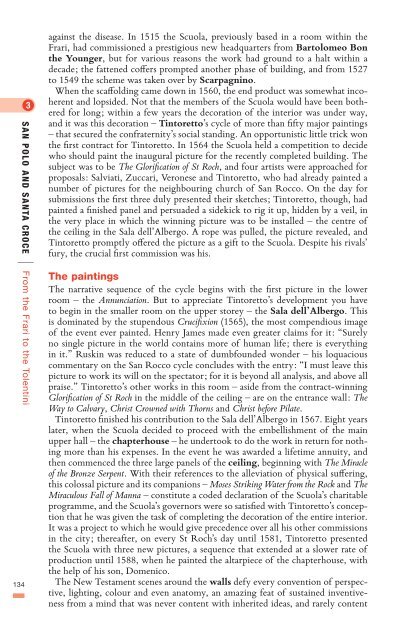You also want an ePaper? Increase the reach of your titles
YUMPU automatically turns print PDFs into web optimized ePapers that Google loves.
San Polo <strong>and</strong> Santa Croce<br />
|<br />
134<br />
From <strong>the</strong> Frari <strong>to</strong> <strong>the</strong> Tolentini<br />
against <strong>the</strong> disease. In 1515 <strong>the</strong> Scuola, previously based in a room within <strong>the</strong><br />
Frari, had commissioned a prestigious new headquarters from Bar<strong>to</strong>lomeo Bon<br />
<strong>the</strong> Younger, but for various reasons <strong>the</strong> work had ground <strong>to</strong> a halt within a<br />
decade; <strong>the</strong> fattened coffers prompted ano<strong>the</strong>r phase of building, <strong>and</strong> from 1527<br />
<strong>to</strong> 1549 <strong>the</strong> scheme was taken over by Scarpagnino.<br />
When <strong>the</strong> scaffolding came down in 1560, <strong>the</strong> end product was somewhat incoherent<br />
<strong>and</strong> lopsided. Not that <strong>the</strong> members of <strong>the</strong> Scuola would have been bo<strong>the</strong>red<br />
for long; within a few years <strong>the</strong> decoration of <strong>the</strong> interior was under way,<br />
<strong>and</strong> it was this decoration – Tin<strong>to</strong>ret<strong>to</strong>’s cycle of more than fifty major paintings<br />
– that secured <strong>the</strong> confraternity’s social st<strong>and</strong>ing. An opportunistic little trick won<br />
<strong>the</strong> first contract for Tin<strong>to</strong>ret<strong>to</strong>. In 1564 <strong>the</strong> Scuola held a competition <strong>to</strong> decide<br />
who should paint <strong>the</strong> inaugural picture for <strong>the</strong> recently completed building. <strong>The</strong><br />
subject was <strong>to</strong> be <strong>The</strong> Glorification of St Roch, <strong>and</strong> four artists were approached for<br />
proposals: Salviati, Zuccari, Veronese <strong>and</strong> Tin<strong>to</strong>ret<strong>to</strong>, who had already painted a<br />
number of pictures for <strong>the</strong> neighbouring church of San Rocco. On <strong>the</strong> day for<br />
submissions <strong>the</strong> first three duly presented <strong>the</strong>ir sketches; Tin<strong>to</strong>ret<strong>to</strong>, though, had<br />
painted a finished panel <strong>and</strong> persuaded a sidekick <strong>to</strong> rig it up, hidden by a veil, in<br />
<strong>the</strong> very place in which <strong>the</strong> winning picture was <strong>to</strong> be installed – <strong>the</strong> centre of<br />
<strong>the</strong> ceiling in <strong>the</strong> Sala dell’Albergo. A rope was pulled, <strong>the</strong> picture revealed, <strong>and</strong><br />
Tin<strong>to</strong>ret<strong>to</strong> promptly offered <strong>the</strong> picture as a gift <strong>to</strong> <strong>the</strong> Scuola. Despite his rivals’<br />
fury, <strong>the</strong> crucial first commission was his.<br />
<strong>The</strong> paintings<br />
<strong>The</strong> narrative sequence of <strong>the</strong> cycle begins with <strong>the</strong> first picture in <strong>the</strong> lower<br />
room – <strong>the</strong> Annunciation. But <strong>to</strong> appreciate Tin<strong>to</strong>ret<strong>to</strong>’s development you have<br />
<strong>to</strong> begin in <strong>the</strong> smaller room on <strong>the</strong> upper s<strong>to</strong>rey – <strong>the</strong> Sala dell’Albergo. This<br />
is dominated by <strong>the</strong> stupendous Crucifixion (1565), <strong>the</strong> most compendious image<br />
of <strong>the</strong> event ever painted. Henry James made even greater claims for it: “Surely<br />
no single picture in <strong>the</strong> world contains more of human life; <strong>the</strong>re is everything<br />
in it.” Ruskin was reduced <strong>to</strong> a state of dumbfounded wonder – his loquacious<br />
commentary on <strong>the</strong> San Rocco cycle concludes with <strong>the</strong> entry: “I must leave this<br />
picture <strong>to</strong> work its will on <strong>the</strong> specta<strong>to</strong>r; for it is beyond all analysis, <strong>and</strong> above all<br />
praise.” Tin<strong>to</strong>ret<strong>to</strong>’s o<strong>the</strong>r works in this room – aside from <strong>the</strong> contract-winning<br />
Glorification of St Roch in <strong>the</strong> middle of <strong>the</strong> ceiling – are on <strong>the</strong> entrance wall: <strong>The</strong><br />
Way <strong>to</strong> Calvary, Christ Crowned with Thorns <strong>and</strong> Christ before Pilate.<br />
Tin<strong>to</strong>ret<strong>to</strong> finished his contribution <strong>to</strong> <strong>the</strong> Sala dell’Albergo in 1567. Eight years<br />
later, when <strong>the</strong> Scuola decided <strong>to</strong> proceed with <strong>the</strong> embellishment of <strong>the</strong> main<br />
upper hall – <strong>the</strong> chapterhouse – he under<strong>to</strong>ok <strong>to</strong> do <strong>the</strong> work in return for nothing<br />
more than his expenses. In <strong>the</strong> event he was awarded a lifetime annuity, <strong>and</strong><br />
<strong>the</strong>n commenced <strong>the</strong> three large panels of <strong>the</strong> ceiling, beginning with <strong>The</strong> Miracle<br />
of <strong>the</strong> Bronze Serpent. With <strong>the</strong>ir references <strong>to</strong> <strong>the</strong> alleviation of physical suffering,<br />
this colossal picture <strong>and</strong> its companions – Moses Striking Water from <strong>the</strong> Rock <strong>and</strong> <strong>The</strong><br />
Miraculous Fall of Manna – constitute a coded declaration of <strong>the</strong> Scuola’s charitable<br />
programme, <strong>and</strong> <strong>the</strong> Scuola’s governors were so satisfied with Tin<strong>to</strong>ret<strong>to</strong>’s conception<br />
that he was given <strong>the</strong> task of completing <strong>the</strong> decoration of <strong>the</strong> entire interior.<br />
It was a project <strong>to</strong> which he would give precedence over all his o<strong>the</strong>r commissions<br />
in <strong>the</strong> city; <strong>the</strong>reafter, on every St Roch’s day until 1581, Tin<strong>to</strong>ret<strong>to</strong> presented<br />
<strong>the</strong> Scuola with three new pictures, a sequence that extended at a slower rate of<br />
production until 1588, when he painted <strong>the</strong> altarpiece of <strong>the</strong> chapterhouse, with<br />
<strong>the</strong> help of his son, Domenico.<br />
<strong>The</strong> New Testament scenes around <strong>the</strong> walls defy every convention of perspective,<br />
lighting, colour <strong>and</strong> even ana<strong>to</strong>my, an amazing feat of sustained inventiveness<br />
from a mind that was never content with inherited ideas, <strong>and</strong> rarely content







